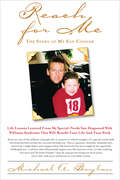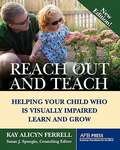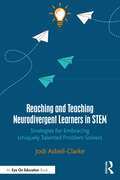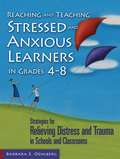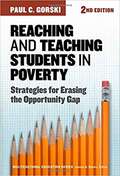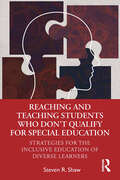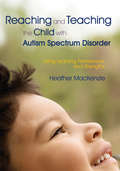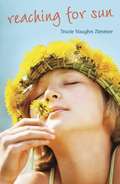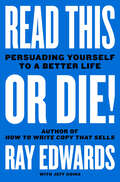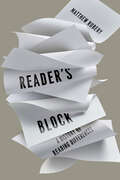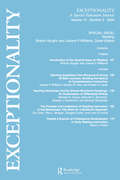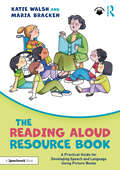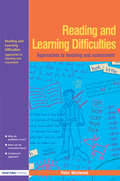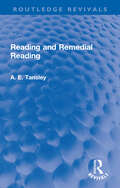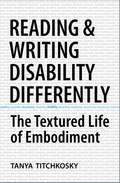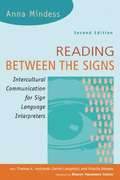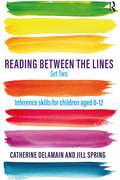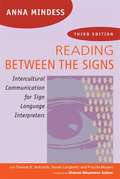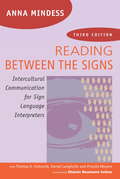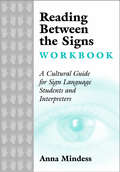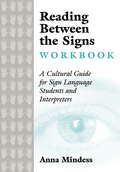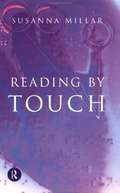- Table View
- List View
Reach for Me: The Story of My Son Connor
by Michael A. BoylanParents and related caregivers of children with special needs have been handed lifelong challenges that test their very fabric as people. Continuous stress, worry and anxiety can be the norm throughout their lives. It&’s hard to relax. Imagine that—not being able to relax or take a break. Every parent of a special-needs child should read this story. It will bring them hope and encouragement. If you are not a caregiver, give Reach for Me to someone who is! Your gesture will acknowledge the challenges they cope with on a daily basis, helping them find inspiration to carry on.
Reach Out and Teach
by Kay Alicyn FerrellPacked with important information for todays parents and professionals, this new edition of a groundbreaking work presents the latest research on how visually impaired children learn and develop at different ages and in the various developmental domains: sensory development, communication, movement, manipulation, and comprehension. Clear, practical, and reassuring, and full of suggested activities, this book provides a guide to teaching young visually impaired children the important life skills they need to know--skills that other children may learn simply by observation and imitation--and preparing them to enter school ready to learn with their peers. From early intervention services to the full range of educational placements, Reach Out and Teach is the ultimate guide to helping a visually impaired child learn and grow.
Reaching and Teaching Neurodivergent Learners in STEM: Strategies for Embracing Uniquely Talented Problem Solvers
by Jodi Asbell-ClarkeProviding salient stories and practical strategies, this book empowers educators to embrace the unique talents of neurodivergent learners in science, technology, engineering, and mathematics (STEM). An exploration of the exciting opportunities neurodiversity presents to build an innovative workforce is grounded in a large body of research from psychology, neuroscience, and education. Author Jodi Asbell-Clarke presents individual examples of neurodivergent journeys in STEM to establish evidence-based connections between neurodiversity and the types of innovative problem-solving skills needed in today’s workforce. The featured stories come directly from the author’s many years in inclusive classrooms with STEM teachers along with interviews from many neurodivergent professionals in STEM. Teachers will learn how to embrace the unique brilliance and potential of the neurodivergent learners in their classroom, working against historic marginalization and deficit-based perspectives of neurodiversity within the education system. Featuring illustrations of classroom-designed tools and materials alongside basic strategies to support executive function and emotion in learning, this book will help you nurture the talents of your neurodivergent learners and recognize their unique potential within STEM. Ideal for K-12 classroom teachers, special educators, learning specialists, psychologists, and school administrators.
Reaching and Teaching Stressed and Anxious Learner: Strategies for Relieving Distress and Trauma in Schools and Classrooms
by Barbara OehlbergThis important new resource helps educators understand how trauma and stress interfere with cognitive skills, and how classroom and school activities can be used to restore feelings of safety, empowerment, and well-being.
Reaching And Teaching Students In Poverty: Strategies For Erasing The Opportunity Gap
by Paul C. Gorski James A. BanksThis influential book describes the knowledge and skills teachers and school administrators need to recognize and combat bias and inequity that undermine educational engagement for students experiencing poverty. The Second Edition features two new chapters—“Embracing a Structural View of Poverty and Education: Ditching Deficit Ideology and Quitting Grit” and “Cultivating School Change through Equity Literacy: Commitments and Strategies for School and District Leaders”—plus extensive revisions throughout based on newly available research and lessons from the author’s professional development work. Gorski outlines the dangers of “grit” and deficit perspectives as responses to educational disparities; offers research-informed, on-the-ground strategies for teaching and leading with equity literacy; and provides expanded lists of resources and readings to support transformative equity work in high-poverty and mixed-class schools. Written in an engaging, conversational style that makes complex concepts accessible, this book will help readers learn how to recognize and respond to even the subtlest inequities in their classrooms, schools, and districts.
Reaching and Teaching Students Who Don’t Qualify for Special Education: Strategies for the Inclusive Education of Diverse Learners
by Steven R. ShawThis book helps readers understand, teach, and support children with persistent low academic achievement who don’t meet special education eligibility criteria, or for whom Tier 2 MTSS interventions are insufficient. Designed to be implemented in inclusive classrooms with minimal resources, comprehensive chapters cover topics from reading, writing, and math to executive functions, SEL, and mental health. This critical, ground-breaking volume provides teachers, psychologists, and counselors with an understanding of the issues children and adolescents with mild cognitive limitations and other causes of low academic achievement face, as well as detailed, evidence-based teaching practices to support their academic and social and emotional learning.
Reaching and Teaching Students with Special Needs through Art
by Beverly Levett Gerber Doris M. GuayThis book has played an important role in reaching and teaching special needs students; its compiled in a simple manner to provide access to its audience. It contains practices, research, and the rationale for art in the education of students with special needs.
Reaching and Teaching the Child with Autism Spectrum Disorder: Using Learning Preferences and Strengths
by Heather MackenzieReaching and Teaching Children with Autism provides a positive approach to understanding and educating children on the autism spectrum. The book gives greater insight into the perspective and behavior of a child with autism and explores how the child's learning preferences, strengths and interests can be used to facilitate learning and enhance motivation. Based on well-researched theory and extensive clinical experience, the author provides a comprehensive model for developing lifelong independent learning skills in children with autism between the ages of 3 and 12 years old. The book describes the underlying principles, learning preferences and strengths typical of children with autism and offers a detailed but flexible program structure based on these concepts. Easy to follow activities and approaches are described in each chapter, along with clear examples and illustrations. This accessible and practical book is an essential resource for parents, teachers, support workers, therapists and others concerned with learning and development in children with autism.
Reaching for Sun
by Tracie Vaughn ZimmerJosie Wyatt knows what it means to be different. Her family's small farmhouse seems to shrink each time another mansion grows up behind it. She lives with her career-obsessed mom and opinionated Gran, but has never known her father. Then there's her cerebral palsy: even if Josie wants to forget that she was born with a disability, her mom can't seem to let it go. Yet when a strange new boy--Jordan--moves into one of the houses nearby, he seems oblivious to all the things that make Josie different. Before long, Josie finds herself reaching out for something she's never really known: a friend... and possibly more. Interlinked free verse poems tell the beautiful, heartfelt story of a girl, a family farm reduced to a garden, and a year of unforgettable growth.<P><P> Winner of the Schneider Family Book Award
Read This or Die!: Persuading Yourself to a Better Life
by Ray Edwards Jeff GoinsDiagnosed with a terminal illness, a leading marketing consultant discovers that what he has learned about persuading others might help him save his own life. Ray Edwards was one of the top marketers and copywriters in the business with A-list clients like Tony Robbins, Jack Canfield, and Michael Hyatt when he was diagnosed with Parkinson’s. The diagnosis brought his life to a screeching halt and propelled Edwards to question everything he thought he knew about his Christian faith, his relationships, what kind of person he was, and how the world worked.Out of options and deeply depressed, Edwards decided he needed to turn his life around or die a failure. He had to let go of false beliefs and find better ones. To his surprise, he found that the principles of persuasion he’d honed for over four decades to move others could work for him. In the vein of The Last Lecture and Tuesdays with Morrie, Read This or Die! Is the tale of one man’s transformation and how he achieved it.Edwards outlines the powerful, time-tested PASTOR process he created that helped him identify and untangle the beliefs that were holding him back and provided a game plan for how to change his life:Pain: start with what hurtsAmplify: determine how it will get worse before it gets betterStory: find the story of a better futureTransformation: choose the evidence worth believingOpportunity: discern where change can happenResponse: set up a system that makes transformation stickFor anyone who wants to turn their life around but does not know how, the PASTOR method teaches how to harness marketing wisdom to get honest about what we really want from life and craft better beliefs and plans to help us start living life on our own terms.
Reader's Block: A History of Reading Differences
by Matthew RuberyWhat does the term "reading" mean? Matthew Rubery's exploration of the influence neurodivergence has on the ways individuals read asks us to consider that there may be no one definition. This alternative history of reading tells the stories of "atypical" readers and the impact had on their lives by neurological conditions affecting their ability to make sense of the printed word: from dyslexia, hyperlexia, and alexia to synesthesia, hallucinations, and dementia. Rubery's focus on neurodiversity aims to transform our understanding of the very concept of reading. Drawing on personal testimonies gathered from literature, film, life writing, social media, medical case studies, and other sources to express how cognitive differences have shaped people's experiences both on and off the page, Rubery contends that there is no single activity known as reading. Instead, there are multiple ways of reading (and, for that matter, not reading) despite the ease with which we use the term. Pushing us to rethink what it means to read, Reader's Block moves toward an understanding of reading as a spectrum that is capacious enough to accommodate the full range of activities documented in this fascinating and highly original book. Read it from cover to cover, out of sequence, or piecemeal. Read it upside down, sideways, or in a mirror. For just as there is no right way to read, there is no right way to read this book. What matters is that you are doing something with it—something that Rubery proposes should be called "reading."
Reader's Digest Select Editions, Volume 126 (Reader's Digest #126)
by Reader's Digest Association Inc.This Reader's Digest volume consists of two condensed selections: Chesapeake Blue by Nora Roberts, and, Eat Cake by Jeanne Ray. The first selection, Chesapeake Blue is about "Seth Quinn, a gifted international artist, returns home to Maryland ready to settle down. But a daring new passion collides with a dark secret from his past, and his life becomes anything but settled." The second condensed book, Eat Cake is about how cake brings a family through crises: "Nothing brings a family together like a warm, delicious slice of cake! Or so believes Ruth Hopson, who bakes so much that her husband, mother, and teenage daughter beg her to stop. But little does Ruth know how important her baking will become to her family when life takes a turn for the worse--and Ruth discovers a strength she didn't even know she had."
Reading: A Special Issue of Exceptionality
by Sharon Vaughn Joanna P. WilliamsFirst Published in 2004. Routledge is an imprint of Taylor & Francis, an informa company.
The Reading Aloud Resource Book: A Practical Guide for Developing Speech and Language Using Picture Books
by Katie Walsh Maria BrackenThis practical guide is the ideal tool for the busy practitioner or speech and language therapist to provide an effective, meaningful, and contextualised approach to language development using picture books. Drawing from up-to-date, evidence-based research, each chapter shows you how to get the most out of picture books to support language development, with a focus on the range of opportunities that reading aloud can bring. The guide offers a complete package to promote speech, language, and early literacy, and to enrich language comprehension, vocabulary, phonological awareness, and oral language – all by using books to provide a context for meaningful language learning. The resource also includes advice on how to develop intervention goals and outcome measures for reading aloud, with practical suggestions covering topics from creating a reading routine and book nooks, to encouraging reluctant readers and reading aloud challenges. Language skills are essential for academic, social and communication success and this reading aloud resource will be valuable reading for early year educators, primary teachers, and speech and language therapists working with young children aged 0-7.
Reading and Learning Difficulties: Approaches To Teaching And Assessment
by Peter WestwoodFirst Published in 2005. Routledge is an imprint of Taylor & Francis, an informa company.
Reading and Remedial Reading (Routledge Revivals)
by A. E. TansleyFirst published in 1967, Reading and Remedial Reading describes the normal reading programme in the school where the author taught and the diagnosis and treatment of acute difficulties in learning to read. The work deals mainly with so-called educationally maladjusted children, many of whom showed signs of possible damage to the central nervous system, but Mr Tansley believes that the methods and techniques given are applicable to all children, irrespective of levels of intelligence, who are experiencing difficulties to learn. The results achieved are most encouraging and have been tested by numerous expert visitors from this country and abroad. This is a helpful guide to a large number of people- staffs and students in University Education Departments, educational psychologists, remedial teachers, special-school teachers, primary school teachers, and medical officers in the School Health Service.
Reading and Writing Disability Differently: The Textured Life of Embodiment
by Tanya TitchkoskyIn this study, Titchkosky analyzes the depiction of disabled people in the mass media. Through an examination of everyday texts such as news stories and government surveys, she uncovers and critiques a Western cultural assumption that sees disability as a clear-cut "problem" in need of a solution. Titchkosky (disability studies, U. of Toronto) is also the author of Disability, Self, and Society (2003). Annotation ©2007 Book News, Inc., Portland, OR (booknews.com)
Reading Between The Signs: Intercultural Communication for Sign Language Interpreters
by Anna Mindess Thomas K. Holcomb Daniel Langholtz Priscilla Moyers Sharon Neumann SolowIn Reading Between the Signs: Intercultural Communication for Sign Language Interpreters, Anna Mindess provides a new perspective on a unique culture that is not widely understood-American Deaf culture. With the collaboration of three distinguished deaf consultants, Mindess explores the implications of cultural differences at the intersection of the deaf and hearing worlds. The book takes a practical approach with many useful suggestions for the sign language interpreter. Mindess provides several helpful dialogues between hearing and deaf Americans in a variety of situations to illustrate the problems that can arise as a result of cultural differences. The compounded difficulty of communicating with a deaf person from another country is addressed as well, with suggestions for ameliorating possible areas of misunderstanding. It also provides helpful information about advances in technology and the multicultural communities within the Deaf world. Reading Between the Signs is an invaluable tool for those interested in training as a sign language interpreter, but further, for anyone wishing to understand American Deaf culture. . A dazzling application of the tools of intercultural communication to illuminating Deaf and hearing cultures and their differences. . This is a book for everyone interested in Deaf culture. -Harlan Lane, author of When the Mind Hears and The Mask of Benevolence Adds a necessary dimension to understanding what sign language interpretation really entails-not the exchange of words for signs and vice versa but the translation of one view of life and all its meanings into another equally valid yet different view -William C. Stokoe, Former Professor Emeritus, Gallaudet University BRAVO The book is outstanding - well written, informative, and desperately needed in our field . -Jan Humphrey, Ed. D. Certified Interpreter, Interpreter Educator and Author of So You Want to Be an Interpreter?A must-read An enlightening book. a defining document in the literature of Deaf culture. -Eileen Forestal, Professor, ASL Studies and Interpreting Training, Union County College Contents Foreword by Sharon Neumann So low Preface Acknowledgments Part One: Background 1 Introduction 2 The Study of Culture 3 Selected Topics in Intercultural Communication 4 Do Americans Really Have a Culture? 5 American Deaf Culture 6 Multicultural Deaf Culture 7 Culture, Change, and Technology Part Two: Practical Applications 8 The Impact of Cultural Differences on Interpreting Situations 9 Multicultural Interpreting Challenges 10 The Interpreter's Role and Responsibilities 11 Techniques for Cultural Adjustments12 Interpreting in a Virtual World 13 Cultural Sensitivity Shouldn't End at Five O'Clock Afterword by Dr. Thomas K. Holcomb Bibliography About the Author and Contributors Index.
Reading Between the Lines Set Two: Inference skills for children aged 8 – 12
by Catherine Delamain Jill SpringReading Between the Lines Set Two is a sequel to the popular Reading Between the Lines. It is a resource book for teachers, teaching assistants, SENCOs and Speech and Language Therapists who need to support the development of inference skills in children aged 8–12. These unique guides offer accessible and easy-to-use material specifically targeted to improve inference, which is a crucial element in understanding spoken and written language. The book provides 370 engaging texts themed around different areas such as place and occupation, and includes short stories about everyday events, magic and adventure. Each short text is accompanied by guiding questions and is carefully graded to allow students to gradually progress from more simple texts with highlighted clues onto more challenging scenarios which will require higher level inferencing skills. Containing handy photocopiable material, this guide can be used with whole classes, small groups or individual children. It will be particularly valuable to professionals working with children who have Autism Spectrum Disorders or Speech, Language and Communication Needs, who need particular support with inference as they develop their broader social communication skills.
Reading Between the Signs: Intercultural Communication For Sign Language Interpreters
by Anna MindessIn Reading Between the Signs, Anna Mindess provides a perspective on a culture that is not widely understood-American Deaf culture. With the collaboration of three distinguished Deaf consultants, Mindess explores the implications of cultural differences at the intersection of the Deaf and hearing worlds. Used in sign language interpreter training programs worldwide, Reading Between the Signs is a resource for students, working interpreters and other professionals. This important new edition retains practical techniques that enable interpreters to effectively communicate their clients' intent, while its timely discussion of the interpreter's role is broadened in a cultural context.NEW TO THIS EDITION: New chapter explores the changing landscape of the interpreting field and discusses the concepts of Deafhood and Deaf heart. This examination of using Deaf interpreters pays respect to the profession, details techniques and shows the benefits of collaboration.
Reading Between the Signs: Intercultural Communication for Sign Language Interpreters
by Anna MindessIn Reading Between the Signs, Anna Mindess provides a perspective on a culture that is not widely understood - American Deaf culture. With the collaboration of three distinguished Deaf consultants, Mindess explores the implications of cultural differences at the intersection of the Deaf and hearing worlds. Used in sign language interpreter training programs worldwide, Reading Between the Signs is a resource for students, working interpreters and other professionals. This important new edition retains practical techniques that enable interpreters to effectively communicate their clients' intent, while its timely discussion of the interpreter's role is broadened in a cultural context. NEW TO THIS EDITION: New chapter explores the changing landscape of the interpreting field and discusses the concepts of Deafhood and Deaf heart. This examination of using Deaf interpreters pays respect to the profession, details techniques and shows the benefits of collaboration.
Reading Between the Signs Workbook: A Cultural Guide For Sign Language Students And Interpreters
by Anna MindessIn Reading Between the Signs, Anna Mindess provides a perspective on a culture that is not widely understood-American Deaf culture. With the collaboration of three distinguished Deaf consultants, Mindess explores the implications of cultural differences at the intersection of the Deaf and hearing worlds. Used in sign language interpreter training programs worldwide, Reading Between the Signs is a resource for students, working interpreters and other professionals. This important new edition retains practical techniques that enable interpreters to effectively communicate their clients' intent, while its timely discussion of the interpreter's role is broadened in a cultural context.NEW TO THIS EDITION: New chapter explores the changing landscape of the interpreting field and discusses the concepts of Deafhood and Deaf heart. This examination of using Deaf interpreters pays respect to the profession, details techniques and shows the benefits of collaboration.
Reading Between the Signs Workbook: A Cultural Guide for Sign Language Students and Interpreters
by Anna MindessThis helpful workbook functions as a companion and supplement to Anna Mindess's earlier book, Reading Between the Signs: A Cultural Guide for Sign Language Interpreters, a recognized classic text for sign language interpreters and ASL students. It is arranged to correspond with the theory presented in the book and expands its focus to the relativity of politeness and the distinction between direct and indirect communication styles, both of which are important elements in comparing Deaf and mainstream cultures. Hands-on exercises allow students to better comprehend the sometimes-puzzling differences of culturally appropriate behavior. The book also helps students explore their own culture as well as the American Deaf culture in ways that reveal the differences between the two. Role play, discussion topics and critical incidents increase first-hand understanding of the relationship between the Deaf and Hearing communities.
Reading By Touch: Trials, Battles, and Discoveries
by Pamela LorimerHistory of reading for the blind.
Reading by Touch
by Susanna MillarThe perceptual, linguistic and cognitive processes involved in sighted reading have been widely studied, but the use of touch raises new issues. Drawing on her research with novice and fluent braille readers, Susanna Millar examines how people initially process braille and how skill with sounds, words, meaning and spelling patterns influence processing. The main focus is on braille, but findings on the "Moon" script, vibrotactile devices, maps and icons are also considered in the context of their practical implications and access to computer technology.
